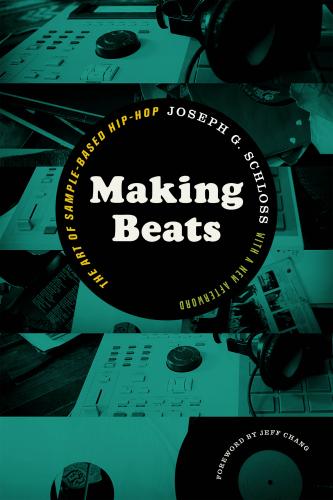Making Beats
Joseph G. Schloss
Making Beats
The Art of Sample-Based Hip-Hop
With a New Afterword Foreword by Jeff Chang
Wesleyan University Press
Middletown, Connecticut
Wesleyan University Press, Middletown, CT 06459
© 2004 and 2014 Joseph G. Schloss
Foreword © 2014 Jeff Chang
All rights reserved
Originally published in 2004
Text design by Julie Allred, BW&A Books, Inc.
Printed in the United States of America
ISBN for this edition: 978-0-8195-7481-7
Wesleyan University Press is a member of the Green Press Initiative. The paper used in this book meets their minimum requirement for recycled paper.
The Library of Congress cataloged the original printing as: Schloss, Joseph Glenn.
Making beats : the art of sample-based hip-hop / Joseph G. Schloss.
p. cm. — (Music/culture)
Includes bibliographical references (p. ), discography (p. ), and index.
ISBN 0-8195-6695-0 (cloth : alk. paper) — ISBN 0-8195-6696-9 (pbk. : alk. paper)
1. Rap (Music)—History and criticism. 2. Hip-hop. 3. Turntablism. 4. Sound recording executives and producers—United States. 5. Turntablists.
I. Title. II. Series.
ML3531.s35 2004
781.64’9149—dc22 2004043013
5 4 3 2 1
“Cover photographs by Shaheen Ariefdien.”
To my parents,
John and Suzanne Schloss,
and to our ancestors
Contents
2 “It’s about Playing Records”: History 25
3 “It Just Doesn’t Sound Authentic”: Live Instrumentation versus Hip-Hop Purism 63
4 Materials and Inspiration: Digging in the Crates 79
6 Elements of Style: Aesthetics of Hip-Hop Composition 135
7 The Outer Circle: From Samplers to Ears 169
New Foreword
Jeff Chang
When, at the turn of the millennium, Joe Schloss completed the dissertation that would become this groundbreaking book, the biggest question facing the field of hip-hop studies was, “So what?”
Rap music was at the very peak of its commercial impact, and hip-hop’s global cultural influence was inescapable. Those facts only gave that question its weight. The academy, having grudgingly granted that hip-hop was not a fad, resisted the idea that the kinds of knowledges it preserved and produced were worthy of study. What, they asked, could hip-hop teach us in the academy?
But perhaps the strongest skeptics of hip-hop studies came from within the movement. What, they asked, can the academy teach me about hip-hop that someone in hip-hop couldn’t teach me better? What could intellectuals offer my movement but patronization and mummification?
These skeptics were people like Schloss himself—committed hip-hop heads concerned they might be pimping their own culture, engaged scholars questioning the relevance of their careers to the communities from which they had come. For Schloss, choosing to write critically about hip-hop meant confronting “So what?” every day he woke up. And if he and his peers—and I count myself alongside him as part of what might be called the second generation of hip-hop scholars—could not find satisfactory answers, the field of hip-hop studies certainly would fade out like a fad.
By now, there was a foundational canon of works by people like Nelson George, David Toop, Steven Hager, Sally Banes, Henry Chalfant, Martha Cooper, Jim Prigoff, Bill Adler, Craig Castleman, and Jack Stewart. Members of the second generation had devoured the works of the pioneers of hip-hop studies like Tricia Rose, Mark Anthony Neal, Harry Allen, Robin D. G. Kelley, James Spady, and Brian Cross. We checked for elders who got it—people like Houston Baker, Juan Flores, and Henry Louis Gates Jr. And we were handing each other new books by Billy Wimsatt, Michael Eric Dyson, Cheryl Keyes, Raquel Z. Rivera, and S. Craig Watkins.
There were also lots of “scholarly” pieces about hip-hop that were garbage. (In truth, the number might be smaller than I recall—I can’t and won’t spend much time in the dustbin of that particular history.) What I do remember is having a classically hip-hop chip-on-the-shoulder ambivalence about imminent institutionalization. When the Brooklyn Museum mounted an exhibition in 2000 entitled Hip-Hop: Roots, Rhymes, and Rage, I was more outraged at seeing The Notorious B.I.G.’s stage wear and childhood 45 singles collection behind glass than I was by the fact that it had taken so long for a major museum to take hip-hop seriously. I chalk it up now to youth, but I can still remember that silent scream in my head—Here we are a mile straight shot from Biggie’s home, him just three years in the grave, and they’ve turned this shit into a mausoleum. We all ain’t dead yet.
But behind the (misdirected) attitude was a fear that our native knowledges might never be honored, much less documented or advanced. At that moment, hip-hop scholarship mostly focused on rap, forget music or any other forms of hip-hop art. Framed by the urgency of the ongoing culture wars, the ever-present concern over Black invisibility and erasure, and a cultural-studies-styled bow to timeliness, this scholarship often utilized narrow textual and/or sociological approaches. Inevitably the writings were sorely—sometimes pathetically—dated by the time they reached publication.
It
